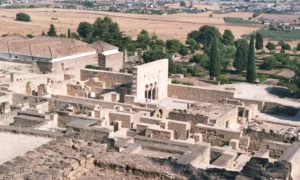The Caliphate City of Medina Azahara, a palatial city complex, stands as a testament to the grandeur of the Umayyad dynasty in al-Andalus. Built by Caliph Abd-ar-Rahman III in the 10th century, it served as a political and administrative center. Located near Cordoba, Spain, the ruins reflect the cultural zenith of the Caliphate of Cordoba. The city was short-lived, however, as it was sacked during a civil war and fell into ruin. Today, it is an archaeological site that offers invaluable insights into Islamic art, architecture, and civilization in medieval Spain.
Umayyad dynasty
The Umayyad Dynasty, spanning from 661 to 750 AD, marked a significant period in Islamic history, establishing the first great Muslim dynasty. Originating from the Umayyad clan of the Quraysh tribe in Mecca, the dynasty was founded by Muawiya ibn Abi Sufyan, who became the first Umayyad caliph after a power struggle with Ali ibn Abi Talib, the fourth caliph and cousin of the Prophet Muhammad. This transition marked the end of the Rashidun Caliphate and the beginning of the Umayyad Caliphate, shifting the Islamic leadership’s base from Medina to Damascus, which became the new capital.
Under the Umayyads, the Islamic empire expanded at an unprecedented rate. Notable military campaigns extended the empire’s boundaries far beyond the Arabian Peninsula, reaching the Atlantic Ocean to the west and the Indus River to the east. This expansion included notable conquests in North Africa, the Iberian Peninsula, and parts of the Indian subcontinent. The Battle of Tours in 732 AD, where the Umayyads were halted by Charles Martel in France, marked the westernmost advance of Muslim armies.
The Umayyad era was also a time of significant cultural, administrative, and architectural achievements. The Arabic language was established as the empire’s official language, facilitating the administration of a vast and diverse territory. The dynasty is renowned for its architectural contributions, including the construction of the Dome of the Rock in Jerusalem and the Great Mosque of Damascus, which stand as monumental symbols of Islamic art and architecture.
Religiously, the Umayyads were Sunni Muslims, and their rule is often characterized by the establishment of a more centralized and imperial form of governance. However, their reign was also marked by internal strife and opposition, particularly from Shia Muslims, who supported the claims of Ali’s descendants over the Umayyads, and from non-Arab Muslims who sought greater inclusion within the Islamic state.
Social and daily life under the Umayyad dynasty varied significantly across the vast empire. In the cities, a vibrant cultural life emerged, influenced by Persian, Byzantine, and North African traditions. The Umayyads also implemented a tax system that, while ensuring the empire’s revenues, discriminated against non-Muslims and non-Arab Muslims, leading to social tensions.
The Umayyad dynasty eventually fell to the Abbasid Revolution in 750 AD, a movement that capitalized on widespread discontent with Umayyad rule. The Abbasids moved the capital to Baghdad, marking the end of the Umayyad era in the East. However, a branch of the Umayyad family managed to escape to Spain, establishing an emirate (and later a caliphate) in Córdoba, which lasted until 1031 AD, preserving the Umayyad legacy in al-Andalus.
The Umayyad rulers were known for their lavish lifestyles and patronage of the arts, which, while contributing to the cultural flourishing of their time, also drew criticism and contributed to the dynasty’s eventual downfall. Despite their controversial rule, the Umayyads played a crucial role in shaping the early Islamic world, laying the foundations for an empire that would endure for centuries.
In summary, the Umayyad Dynasty was a pivotal period in Islamic history, characterized by rapid territorial expansion, cultural and architectural achievements, and the establishment of a centralized Islamic state. Despite facing internal and external challenges, the Umayyads significantly influenced the religious, social, and political landscape of the medieval Islamic world.

